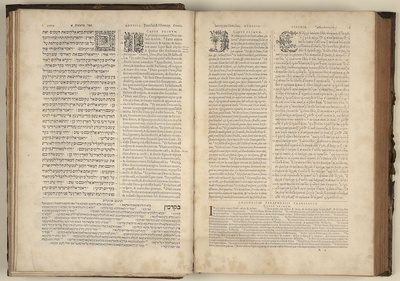
Polyglot Bible
Polyglot bibles contain side-by-side versions of the same text in several different languages, usually Hebrew and Greek alongside historical translations.
Polyglot bibles are useful for studying the history of the text and its interpretation.
A famous early example of a polylgot Bible is Hexapla from the third century BCE. This was a manuscript containing the Hebrew text of the Old Testament, alongside a transcription in Greek letters and four different Greek translations. It was one of the sources used by St. Jerome.
In the Renaissance, printed polyglots flowered, creating the need for fonts to typeset the languages of the Middle East.
A well-known example is the Antwerp Polylgot or Biblia Polyglotta, printed by Christopher Plantin in eight folio volumes between 1569 and 1572. It contains Hebrew, Greek, and Aramaic texts of the Old Testament, each with their own translation, and the New Testament in Greek and Syriac, again with a Latin translation for both. It also contains a complete Hebrew Bible, a complete Greek Bible, a complete Bible with Latin printed between the lines, and several dictionaries and grammars. In short, it offered a complete tool set for the study of the Biblical texts.
The cover image of Brill Polyglot Bible shows the first page of Genisis from the Biblia Polyglotta.
In the digital age, polylgot Bibles continue to delight and to inspire. Online readers, such as Scaife, habe side-by-side comparison at their heart. Libraries may create sites - such as this one by the Newberry Library in Chicago - to demonstrate how polyglots aimed at representing their texts in the most accurate and perfect form possible. In this way, polyglots helped lay the foundation for the study of texts and textual history and stimulated research, teaching, and learning in the humanities.
Brill Polyglot Bible is not a scholarly publication. It is a showcase of possibilities.
The aim is to collect the books of the Bible in the major languages of the ancient world and to publish them in CTS compliant TEI XML on Brill Scholarly Editions.
In this way, each Biblical passage has a persistent and unique identifier and can be retrieved. This means, for example, that a reference to a Biblical passage in a monograph or journal article can be turned into a hyperlink, so readers can review the passage and its context.
A further possibility is to connect the passages to Biblical iconography using the Iconclass classification system, so readers can go from, for example, an image of the annunciation in the Lexikon der christlichen Ikonographie Online to Luke 1:26-38 in the Brill Polyglot Bible and vice versa.
Brill Polyglot Bible is in Open Access.